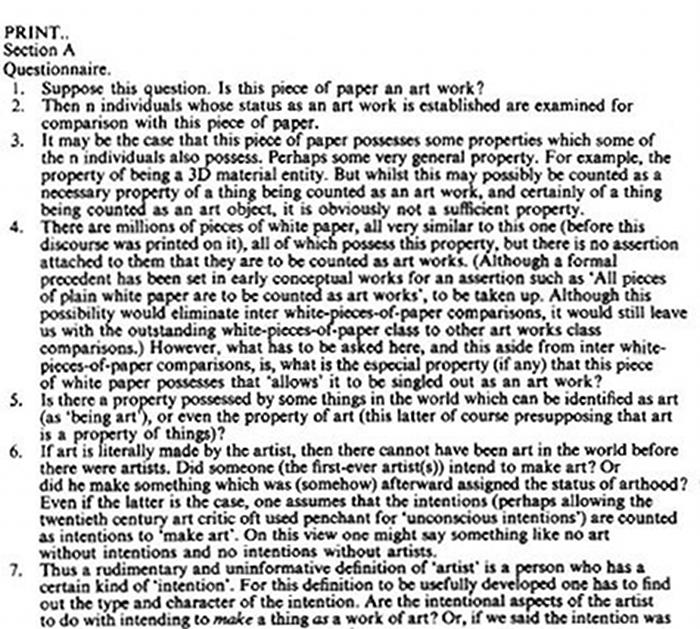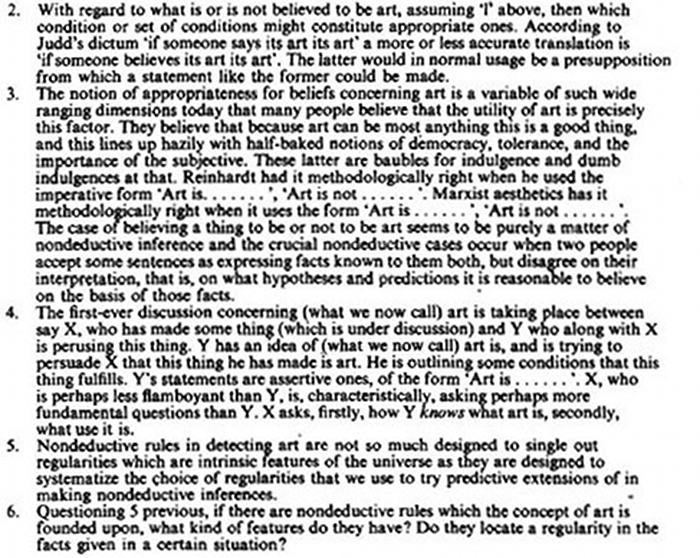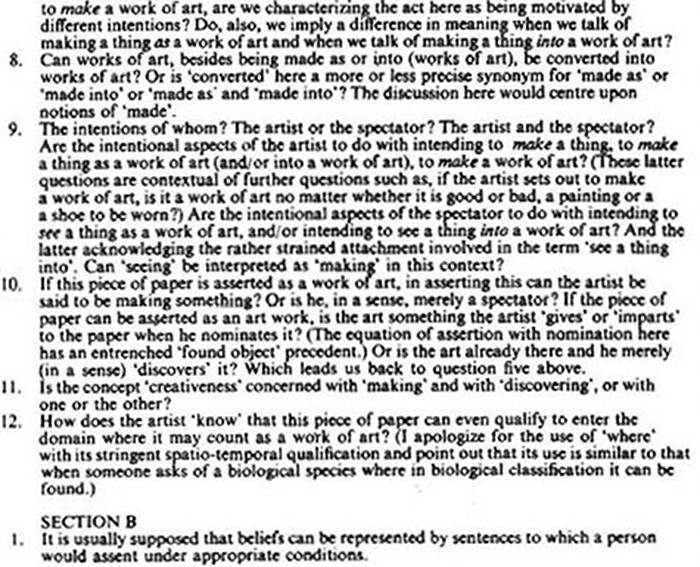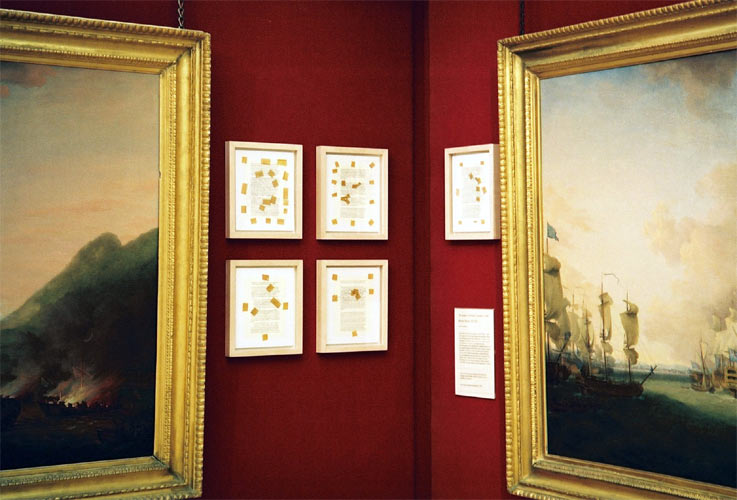Frances Morris: Painting all Over?
”Dag Erik Elgin’s ’Balance of Painters’ comprises 49 canvases, small in scale and almost object-like, aligned vertically, painted in a range of pastel colours: each one bears a column of four numbers in serif-typeface on a scale from zero to eighteen. We tend to conjecture systems painting as belonging to the age of conceptual art – think of On Kawara’s date paintings – but the key to this series is drawn from the 17th century painter and art critic Roger De Piles’ system for evaluating the merits of painters from the renaissance and baroque periods. Publishing in 1708, De Piles ranked over 50 painters, including Michelangelo and Rubens, in four categories: composition, drawing, colour and expression. While clearly evoking the formal and intellectual strategies of conceptualism – the industrial look, the serial format, the use of the sign, and the seeming opacity of the subject matter – Elgin’s work recalls an era where the components of a painting – arguably all paintings – could be quantified and measured for their aesthetic worth.”
Text excerpt from: the catalogue of Carnegie Art Award 2014, Carnegie Art Award Publishing, 2013.
Arve Roed: Museum Impressions. Dag Erik Elgin "La Collection Moderne", MGM Gallery 28.01.–27.02.2010 (Norwegian Art Yearbook, Vol 19, 2011, pp 129-133).
Dag Erik Elgin homes in on the museum experience in his ongoing project, “La Collection Moderne”. This is the title Elgin has given to a number of exhibitions, the latest of them at Galleri MGM in February last year, all of which can be described as contemplative explor ations of the various guises that modernism has assumed in art. The project can also be read as illustrative of Elgin’s development as an artist. Now fortynine years old, this professor at the Oslo National Academy of the Arts started out studying in Germany, after which he made a name for himself in the late 1980s with figurative paintings of almost aristocratic refinement. Inspired by high classical culture – with its elegant architecture, magnificent portals and temple columns – he created paintings that seemed a cross between Giorgio de Chirico’s surreal depictions of urban spaces and the neoexpressionism of continental Europe in the 1980s. His more recent pictures have tended more towards the abstraction and decorativeness of highmodernism, works in which pattern, networks of lines, and expanses of black suggest a medita tion on minimalist reduction and antipainting trends. One senses a common thread running through his output, from the early works through to the succinct, discourse driven “postpainting” paintings of “La Collection Moderne”.
Elgin demonstrates a clear analytical disposition – an inclination to probe the traditions and institutional preconditions for painting. He combines a decorative, formalist idiom with a deep interest in conceptual considerations and a precision of execution that seems both coolly masculine and aesthetically subtle. For his exhibition at MGM, Elgin drew attention to the tiniest signifiers of the didacticism and periodic, archival order typical of the institution, while at the same time suggesting ways of viewing art collections from a structural per spective. Each of the thirtyodd small paintings, executed in oils on canvas and of various formats (most of them around 25–30 x 40–45 cm), represents the wall text that accompanies a major painting from the modernist canon in the museum where it is usually on display – factual information such as the artist’s name and the title of the work. The colouring in Elgin’s pictures varies from one canvas to the next: from white through a range of pastel halftones to dark grey. Each picture has its own text, applied with a brush and by means of a stencil, in shades that are no less varied than the colours of the monochromatic backgrounds. Here one found everything from Picasso’s Guernica (from Reina Sofia in Madrid), the most modern work on the list (1937), René Magritte’s Ceci n’est pas une pipe (1929) and Kazimir Malevich’s Black Square (1915), to Édouard Manet’s depic tion of the World Exhibition in Paris (1867) and Gustave Courbet’s Origin of the World (Musée d’Orsay, Paris) from 1866, the oldest work referred to in the exhibition.
Viewed in reverse, this sequence amounts to a stylised historical progression from birth – Courbet’s painting famously depicts a woman’s exposed crotch – to war, destruction and death in Picasso’s horrifying depiction of the Spanish Civil War. The time span stretches from 1860s Paris and the first avantgarde (Courbet, and the early Impressionists) to the thres hold of World War II, when New York came to replace Paris as the world’s artistic capital; thus it covers the birth, development and heyday of modernism. This art historical review does not obscure the fact that “La Collection Moderne” is first and foremost about the medium of painting, and its possible levels of significance. Most obviously there are the works alluded to, all of which are paint ings, but in addition there is the use of the traditional technique, which, for all its restraint and visual par simony, still shows a painterly appetite and a sensitivity for the materials.
When we consider the project’s conceptual aesthetic and starting point (we are reminded of concept art’s penchant for cataloguing and archiving), we imagine it would have been more efficient to produce the works by means of silkscreening or photocopying, or at least through the use of a faster drying acrylic paint. But Elgin evidently has the heart of an old painter and yearns for the pleasure to be found in the material and visual richness of oils. Admittedly, this is something we only get by studying the works at close quart ers. One has to scrutinise them carefully to see the brushstrokes and the pastosity of the paint, which is laid on thickly through the font stencils, forming a shallow relief on the surface of the canvas. In places the paint has seeped beneath the stencils, leaving tenta tive traces of the studio work and the actual gesture of painting.
The fate of “gestural” painting in late modernism and postmodernism is, we can assume, a widely known fact about art history, and as such it also forms a premise for Elgin’s project. Here I am thinking of, for example, the tendency in abstract expressionism to regard the brushstroke as an “imprint of the soul”, as opposed to the postmodern inclination to view all elements of a painting as quotes and “signs”. As the painting grad ually evolved from an inspirited object – the meaning of which was, so to speak, latent within the material – to an exercise in the handling of concepts, its physical devices and visual effects were redefined as semantic elements or codes amenable to definition, systemisation and control. “La Collection Moderne” lends itself quite naturally to this kind of reading. There is of course a highly appropriate, linguistic joke here in the phrase “oil on canvas”, which features in all the depicted wall texts (albeit in a different languages) while at the same time itself consisting of oil on canvas. The project is both text as image and image as text, or put another way: textual pictures of picture texts. In these works the sign and the signified, the description and the described, are interfused with wry humour.
Elgin is a formalist who is steadily drifting towards the field of concept art. In an exhibition he held in Paris in 2009 (“Dysfunc tional Male Parent”, Galerie Nivet Carzon), he introduced text super imposed on dark grey, abstractly patterned paintings in such a way that the text and the picture seemed almost mutually exclusive. The text, which consisted of simple phrases and sentences, disturbed the viewer’s experience of the paintings as a medium of visual contemplation, while the patterns made it difficult to read the texts. In one of the paintings, the highly appropriate phrase “Destruction of detail” was superimposed on a network of grey stripes against a black ground. This repudiation of detail effectively sums up the minimalist project as it developed from Malevich, via Ad Reinhardt’s black monochromes, and even tually led to a broad field of purist artistic strategies based more or less on the rejection of aesthetic features. Looking beyond the flirtation with the material sen suality of oil paint, Elgin’s analyt ical project can be grouped together with various other forms of institutional critique and conceptual art from the past thirty years: from Michael Asher’s interventions in the physical spaces of institutional art to Louise Lawler’s photographs of collections and archives. Compared with such figures, Elgin is admittedly more cautious, scholarly and refined. His potentially “critical” perspective does not come across as antagonistic, but rather as an exploration of the seemingly contradictory relationship between the conceptual and the “painterly”. In his works, the act of painting is reduced to a reference, almost a metaaction, but executed with an aesthetic yearning that is likely to confuse the viewer. “La Collection Moderne” is a declaration of love for painting, the museum and art history, combined with the artist’s own search for a way forward
– which he fails to find. Despite the references to the many more or less radical breaks with tradition that the original works represented in their own day, the gallery as we experience it in “La Collection Moderne” remains a sanctuary for diversity and refined recreation. But as such it is also symptomatic, for who in the world of today’s contemporary art still believes in iconoclasm? Who today really wants to renounce the museum?
For Elgin the museum – and art – seems first and foremost to be a repository of conserved, hierarchical knowledge, which, if not exactly challenging, at least serves personal development and the expansion of horizons. And from that perspective one should of course not underestimate the significance of the original – and the original’s – wall text as an influence on our dialogue with and experience of art. For who can say in all honesty that they don’t first stoop down to squint at the little plaque to the left of the picture frame during museum visits?

: A piece of paper (I), 2011

: A statement (II), 2011

: An art work (III), 2011

Art&Language: Now They Are Surrounded 2005/2007